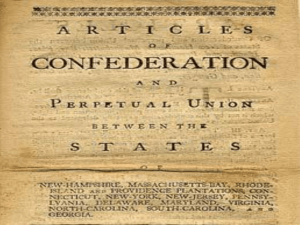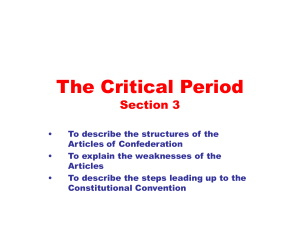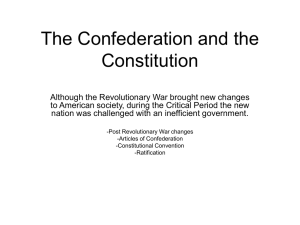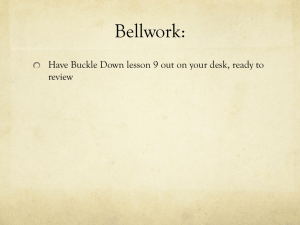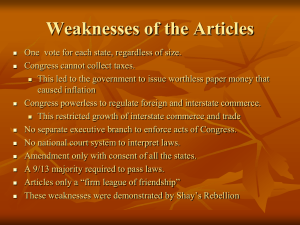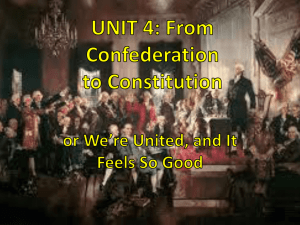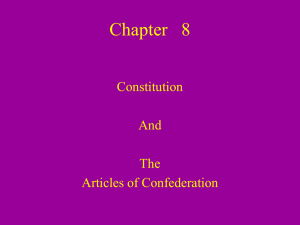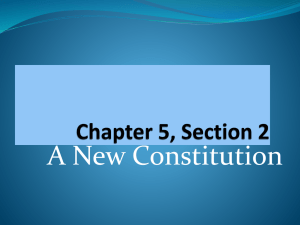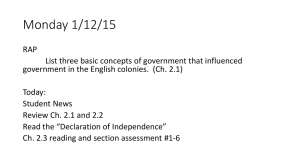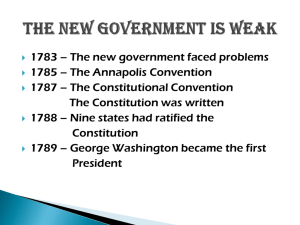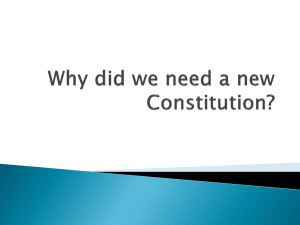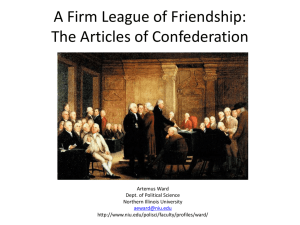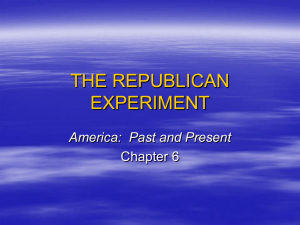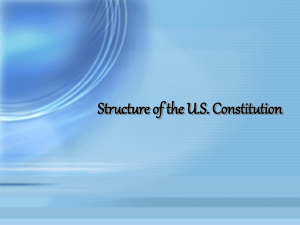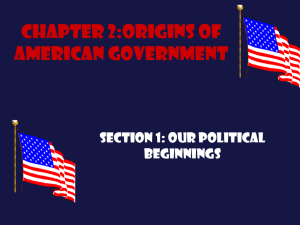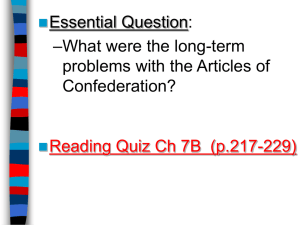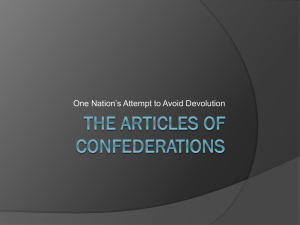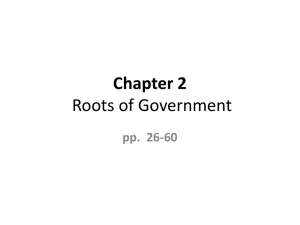Chapter 7 Notes
advertisement
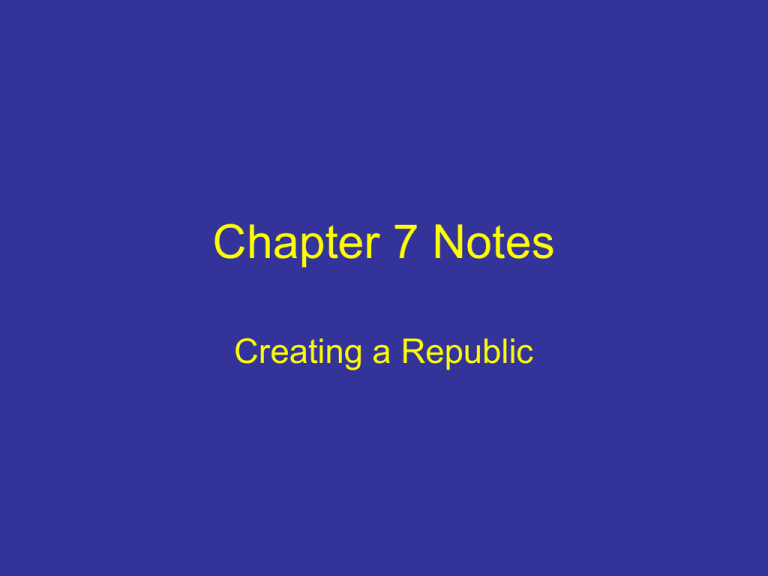
Chapter 7 Notes Creating a Republic Chapter 7 Section 1 Notes A Loose Confederation I. The States Write Constitutions A. Most states wrote their own constitutions B. It sets out the laws, principles, organization, and processes of a government C. Wrote for two reasons 1. spell out all rights of all citizens 2. limited the power of the government D. States divided power between executive and a legislature 1. Legislature passes laws 2. governor carries out the laws (except Pennsylvania) E. Voting requirements 1. must be white 2. must be 21 years of age 3. must be male 4. must own property or pay a certain amount of taxes II. The Articles of Confederation A. Continental Congress is drafting a plan for the nation as a whole 1. felt the states should be united under a national government to win independence B. States reluctant to give up power to a central government C. The Articles of Confederation created a loose alliance of 13 independent states 1. States sent delegates to congress 2. one vote per state 3. congress could declare war, appoint military officers 4. coin money 5. responsible for foreign affairs D. Congress powers were still limited 1. Congress could pass laws, 9 states had to approve it though 2. Congress could not regulate trade 3. no power to tax 4. if congress needed money they asked states for it, they could not raise it 5. no president to execute laws 6. states had to enforce the laws passed by congress 7. no courts III. Weakness of the Confederation A. Disputes between states 1. Congress did not have the power to resolve some of these conflicts B. Money problems 1. after the revolution the U.S. owed millions of dollars a. Congress could not tax – no way to pay dept b. States sometimes refused to lend money to congress 2. begin printing paper currency (money) a. Not much value (no gold or silver to back it up) C. Money was not worth much D. Each state had its own form of currency 1. made trading very difficult E. Other nations took advantage of the confederation IV. Admitting New States A. Congress did pass laws about how to govern the the Northwest Territory 1. North of the Ohio River 2. East of the Mississippi River B. Congress stated how they would be governed and how they could become a state C. Land Ordinance of 1785 1. system for settling the Northwest Territory a. Surveyed b. Divided the land into townships 1. townships divided into 36 Sections a. 1 section = 1 square mile c. Sections cost $640 (640 acres per section = $1 per acre) D. Northwest Ordinance 1. Set up government for the Northwest Territory a. Guaranteed basic rights b. Outlawed slavery 2. vast area that could be divided into smaller territories in the future 3. must have at least 60,000 free settlers a. Then it could ask congress to be admitted as a new state 4. Northwest Territory was divided into a. Ohio b. Indiana c. Illinois d. Michigan e. Wisconsin V. A Call for Change A. Farmers revolt 1. Depression a. Activity falls b. Prices fall c. Wages fall 2. war takes a toll on farmers a. They could not pay their loans back 1. farms were seized b. Farmers believed they were treated c. Daniel Shay and more than 1,000 farmers took part in Shay’s Rebellion 1. attacked the courthouse 2. stopped the seizure of farms 3. The rebellion was a sign that the Articles of Confederation was not working 4. called for a convention to revise the Articles of Confederation 5. Met in Philadelphia in May 1787 a. They would create an entirely new framework of government Chapter 7 Section 2 Notes The Constitutional Convention I. Opened on May 25, 1787 in the State House in Philadelphia, PA A. Its purpose was to revise the Articles of Confederation B. Every state but Rhode Island sent representatives II. Delegates to the Convention A. An amazing assembly 1. 55 delegates; 8 had signed the Declaration of Independence 2. George Washington was elected president of the convention 3. James Madison had done research on history, politics, and commerce 4. the Convention’s meetings were done in secret so that delegates could speak their minds freely without outside pressure III. Two Rival Plans A. Virginia Plan – Edmund Randolph and James Madison 1. Strong national government with three branches – legislative, executive, and judicial 2. Two house legislature – seats in both houses would be awarded on the basis of population B. New Jersey Plan – William Paterson 1. Three branches of government 2. one house legislature – each state would have only one representative regardless of population Virginia Plan 1. Strong National Government 2. 3 Branches of Government 3. Two House Legislature Based on population 4. Liked by large states New Jersey Plan 1. Three branches of government 1. 3 Branches of Government 2. one house legislature Equal Representation 3. Liked by small states C. Great Compromise – Roger Sherman 1. legislature with a lower and an upper house 2. lower – House of Representatives a. Seats would be awarded to each states according to its population b. 435 members voted on by the people of their district – Texas has 32 3. Upper – Senate a. Each state would have 2 representatives b. Early on chosen by state legislatures; today all members are elected by the voters of their state Great Compromise By Roger Sherman 1.Legislature with 2-houses Lower- House of Representatives Seats based on Population Upper – Senate Each state will have two representatives IV. North – South Compromise A. Three – Fifths Compromise – 3/5 of the slaves in any state would be counted toward that state’s population B. Slave Trade Compromise – Congress could not outlaw slave imports for 20 years V. Signing the Constitution A. Signed on September 17, 1787 by all but 3 delegates who feared the national government had too much power B. Each state had to hold a convention to approve or reject the new government Chapter 7 Section 3 Notes Ideas behind the Constitution I. Lessons of Rome’s Republic A. Delegates at the Constitutional Convention wanted to create a republic, a government where citizens rule themselves through elected representatives B. The Roman Example 1. independence and public service were virtues the Founding Fathers saw in Rome 2. Roman citizens served in public office because they were devoted to their republic C. The Roman Warning 1. no republican can survive unless its citizens remain independent and devoted to public service 2. Rome became a dictatorship under Caesar Augustus a. Dictatorship – one person or a small group has complete authority b. Without educated and dedicated citizens republics decay II. Britain's Traditions of Freedom A. Magna Carta: limited the power of the ruler B. English Bill of Rights: protected rights of people including jury trials & habeas corpus III. The American Experience A. House of Burgesses B. Mayflower Compact C. The Revolutionary Era – remembering the abuse of the king, the framers divided the powers of the government 1. President was “Commander in Chief” of armed forces 2. court system was separate from President and Congress IV. Teachings of Enlightenment A. John Locke 1. all people have natural rights to life liberty and property 2. government is an agreement between the ruled and the ruler 3. these ideas were also used in the Declaration of Independence B. Montesquieu 1. Separation of powers into three branches a. Legislative – makes laws b. Executive – carries out laws c. Judicial – interprets the law 2. stressed the rule of law Chapter 7 Section 4 Notes Ratification and the Bill of Rights I. Ratifying the Constitution A. Nine of thirteen states had to approve before it went into effect B. Federalists supported the Constitution 1. favored a strong national government 2. James Madison, Alexander Hamilton, John Jay wrote essays that are collectively called The Federalist Papers and show support for the constitution C. Antifederalist opposed the Constitution 1. states were too weak 2. President had too much power 3. no Bill of Rights D. In June of 1788 New Hampshire becomes the ninth state to ratify the Constitution; Rhode Island was the last to ratify II. Bill of Rights A. The framers did not want people to make changes to the Constitution lightly, so they made the amendment process difficult 1. twelve amendments were sent to the states 2. by December 1791, ten had been ratified B. These first ten amendments were called the Bill of Rights 1. written by James Madison 2. list the natural rights people have The End

